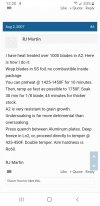- Joined
- Jan 1, 2014
- Messages
- 67
What are some of the heat treat recipes people use for A2? I’m interested in cryo and non cryo options. I have some hand plane irons to make and haven’t worked with this steel before. Thanks in advance!
The BladeForums.com 2024 Traditional Knife is available! Price is $250 ea (shipped within CONUS).
Order here: https://www.bladeforums.com/help/2024-traditional/
Can you elaborate a bit? Thankssuper easy and forgiving steel, I love it. Pretty narrow parameters, adjust the flavour with tempering temp. You'll get a little more hardness from a cold treatment, and I've had good success just adding some freezer time to the quench process. I use LN2 for everything now, but I wouldn't hesitate to make a dependable blade from A2 without it
I do better with specific questions rather than elaborating generallyCan you elaborate a bit? Thanks
Dry Ice sublimates and has no liquid state at room temperature and pressure. The gas vapor barrier between the surface of the steel and the solid DI does not transfer the heat as well as a liquid. To a degree, the steel "floats" on a layer of carbon dioxide gas.May I ask a question slightly off track but related to the cryo treatment.
Is there any advantage in mixing the dry ice with a solution (alcohol or acetone) rather than simply laying the heat treated blades in between dry ice blocks. I have tried both and have not really seen any difference. If the steel gets -110 simply laying on dry ice, why mess with the mix ?
Heat treat ovenDo you have a furnace?
Hoss
When you said freezer time at what point and how long?I do better with specific questions rather than elaborating generally
once the steel comes out from between the plates, I take it out of the envelope and run it under cold water til the steel's cool and then into the freezer for a couple hours. From what I understand most of the benefit of a cold treatment occurs as the steel reaches the lowest temperature, and in the case of A2 there's not much more to be gained past that point. A2 can make for a good knife even without any cold treatment, so I wouldn't worry about it either way.When you said freezer time at what point and how long?

Hi all! Thanks for all the great info!
How necessary is it to wrap A2 in SS foil in the kiln?
I’m about to do my first A2 blades and not wanting drop another $70+ on foil at the moment. But I guess I’d better just used to that as It seems like it’s just part of the game… also, where do y’all get your foil?
